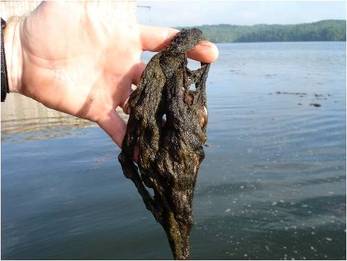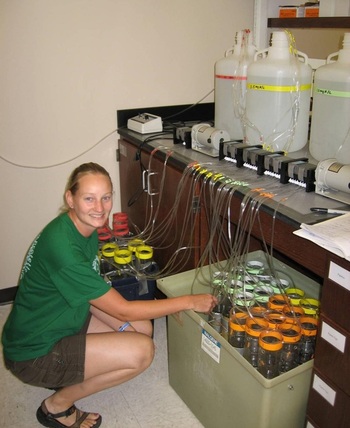
The nuisance algae, Lyngbya, which is proliferating in many of the freshwater coastal springs in Florida. We are studying what environmental factors are contributing to its’ growth.
Increased nutrient concentrations, especially nitrogen and phosphorus, degrade water quality and contribute to ecological problems such as algae blooms and fish kills. Wetlands and riparian areas serve as natural water filters by providing an environment that promotes the uptake and transformation of nutrients and other pollutants. We conduct research aimed at finding natural, cost-effective ways of utilizing ecosystem processes to address real-world water quality concerns.
Our work in water quality includes studying the efficiency of constructed wastewater treatment wetlands and natural wetlands at removing nutrients and other pollutants. Currently, we are working at the Orlando Wetlands Park to evaluate the potential to impose period dry-downs in the treatment wetlands to promote soil consolidation and oxidation as a management technique for improving hydrologic efficiency and maximizing nutrient removal. We are also working with the Florida Department of Transportation to improve the design of stormwater basins to leverage the natural properties of native soils to remove nutrients.
Our lab also conducts research evaluating the effectiveness of coastal restoration projects in mimicking the ecosystem services provided by natural systems. Specifically, we are working with a team of interdisciplinary scientists to determine the ecological impact of oyster reefs and living shoreline restorations on both the natural and human system (e.g., how does engaging in ecosystem restoration impact the resilience of the environment and the local community?). The ABL is spearheading the effort to determine the role of restored oyster reefs and living shorelines in sequestering, storing, and transforming carbon and nutrients that may otherwise contribute to coastal eutrophication.

Testing the effects of different nitrate concentrations on soil denitrification rates.
Current Funding:
2022-2024- Indian River Lagoon National Estuary Program- Unintended Consequences: Are Non-Plastic Materials Now Used in Coastal Restoration Always Better for the Indian River Lagoon?
2021-2023- Florida Department of Transportation- Design of Stormwater BMPs for Surface and Groundwater Protection Based on Site-Scale Soil Properties: Phase I. PI: K. Kibler; Co-PI: M. Beazley
Past Funding:
2019-2021- City of Orlando- Assessing the Effectiveness of Dry‐Down to Reduce Soil Elevation in a Treatment Wetland.
2016-2021- National Science Foundation, Coupled Natural Human Systems- Restoration and Resilience in Coupled Human-Natural Systems: Reciprocal Dynamics of a Coastal ‘Lagoon in Crisis.’ PI: L.J Walters; Co-PIs: L.G. Chambers, T. Hawthorne, K. Kibler, F. Rivera, and G. Cook
2016- Desert Research Institute- Understanding the potential for oyster reef restoration to enhance denitrification in Indian River Lagoon. PI: L.G. Chambers
2014-2015- National Fish and Wildlife Foundation, Five Star and Urban Waters- Lower Meramec Hands-On Stewardship & Watershed Education. PI: K. Dockery; Co-PIs: L.G. Chambers and L. Reuter
2005-2007- US Environmental Protection Agency, Section 319 Non-Point Source Pollution Grant- Honey Creek Stream Bank Repair; West Fork Restoration & Conservation. PI: Honey Creek Watershed Association.
